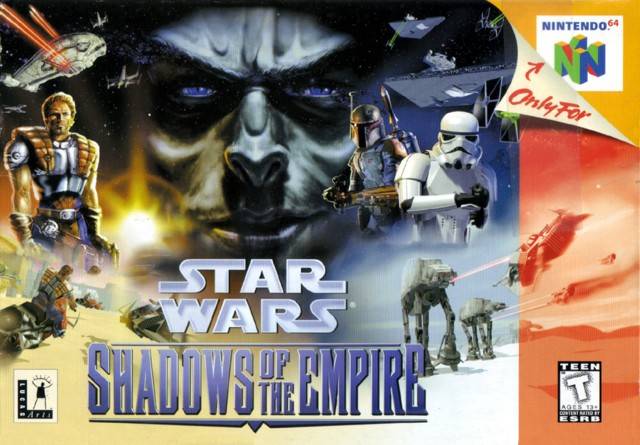Developer: LucasArts Publisher: Nintendo
Released: December 3, 1996 Rated: T 7/10
Patrons at the 1996 E3 got plenty of reason to be excited for the upcoming release of the Nintendo 64, in part due to an impressive recreation of the Battle of Hoth from the upcoming Shadows of the Empire. A fully-3D, free-moving flight across the frozen wastes in a Snow Speeder, shooting down AT-STs and pulling down Walkers with the tow cable. And then for a while, that was all anybody ever decided was worth talking about in Shadows of the Empire. Like, for a long time. It’s gotten to the point where public opinion of Shadows of the Empire was an awesome intro sequence followed by a gross mishmash of clunky platforming, awkward shooting, and overall unfocused genre flirting that wasn’t worth playing past those first 10 minutes. And I’ve just never felt that that was true.

In context, Shadows of the Empire was an ambitious multimedia project for a Star Wars franchise coming up on the infamous prequel trilogy, centered around a piece of software that provided an early cornerstone of the N64 library and first holiday release season, and a lot of groundwork for future titles on the system across a handful of important genres, most notably the exploration-based shooting and platforming that makes up the majority of its runtime. Players control Han Solo facsimile Dash Rendar as he fights in and later escapes from the aforementioned Battle of Hoth at the beginning of Empire Strikes Back alongside the more familiar faces of the franchise, before following him on an adventure during and following the events of Episode V that sees him coming to the aid of Han, Luke, and Leia, culminating in a showdown against Prince Xizor, a powerful crime boss on Coruscant with ties to the Empire.

Across a total of 10 levels, Dash spends six of them on foot, running (dashing, as it were), jumping, operating switches, elevators, and somewhat infamously, a temperamental jetpack. The others include other spaceship shooting segments such as the Snow Speeder scene and the final battle, and a speeder bike race through Mos Eisley. And while the bike race is an admittedly rough but quick little diversion, and the other two flight levels aren’t quite as strong as the opener, Dash on foot certainly doesn’t deserve to be passed over. There’s a variety even in these levels that’s worth exploring them. The Escape from Echo Base that immediately follows the first level is an excellent blend of this varied platforming and shooting through oddly labyrinthian hallways and dangerous caverns that sets the tone of tense exploration really well, taking down Stormtroopers and Wampas that lurk behind doors and corners like zombies in the Spencer Mansion.

Further levels add variety with interesting concepts that, though hit and miss, are still plenty admirable in the way that help the scope of the adventure match that of the films that inspired it. Levels like Ord Mantell’s Junkyard that take place almost entirely on moving train platforms that must be jumped between and balanced on while also fighting off enemies, or the unusually drawn out Gall Spaceport that has you learning to traverse massive chasms for nearly 45 minutes on a tricky, fuel-guzzling jetpack, before utilizing said jetpack in an intense boss fight against Boba Fett and the Slave I. The balancing of consistent mechanics and their respective physics like learning to build up or let off momentum while running and leaping across dangerous platforms, strafing and utilizing lock-on aiming and various weaponry to take out enemies efficiently, and timing sprints and jumps through and around various environmental dangers understandably makes for an uphill battle in a game that often seems to have the drop on you, and constantly changes up other gimmicks for you to work around. But in an early release schedule still populated as much by arcade ports as games that truly take advantage of the fresh hardware its made for, Shadows of the Empire does a lot of things that you really want to see from big studios buying into a burgeoning piece of hardware. It’s a game that offers one of the most fully-realized presentations of a beloved universe up to that point, tries a multitude of ideas and takes risks to create a varied and exciting experience worth the money, and still delivers on bells and whistles like excellent sound design between established John Williams film compositions and atmospheric compositions by Joel McNeely. It may not have held up perfectly like the Star Wars games that immediately follow it, but it’s hard to imagine many of LucasArts’s other late-’90s Star Wars offerings coming out with as much polish and lasting appeal without a lot of groundwork and precedent set by this launch-window swing for fences.
Continuing Legacy
While I’d struggle to say that modern Star Wars titles like the Battlefront series or Jedi: Fallen Order owe all that much to Shadows of the Empire and not the dozens of Star Wars titles in between, the N64’s subsequent Star Wars titles show a lot of influence from ideas flashed here. Although Star Wars flight sims like X-Wing and TIE Fighter were nothing new, the on-planet mission structure of both Rogue Squadron and Episode I: Battle For Naboo bears much more resemblance to that much-lauded Battle of Hoth sequence, while even the maligned speeder bike race on Tatooine feels a little familiar (albeit functionally sound) to anyone who’s played Episode I Racer. Even a few years down the line, it’s tough to say that large sections of Star Wars: Bounty Hunter for the PS2 and GameCube don’t take a lot of notes from the main sections controlling Dash Rendar across Coruscant, Echo Base, and more.
Additional Information
Saves: Cartridge
Compatible With: None
Players: 1
Print Guides: Prima
Aggregate Critical Reception (GameRankings): 73.61%, based on 11 reviews
Other Releases: JP, June 14, 1997
EU, March 4, 1997
My Streams
Commercials and Print Ads






